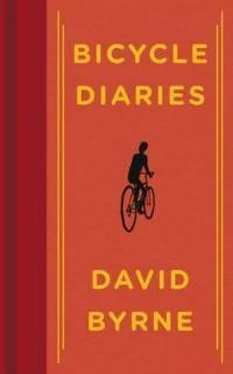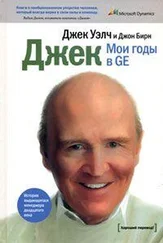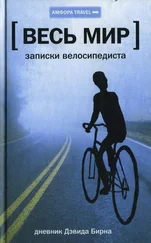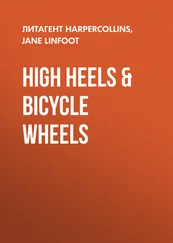It’s a big window and it looks out on a mainly urban landscape. (I’m not a racer or sports cyclist.) Through this window I catch glimpses of the mind of my fellow man, as expressed in the cities he lives in. Cities, it occurred to me, are physical manifestations of our deepest beliefs and our often unconscious thoughts, not so much as individuals, but as the social animals we are. A cognitive scientist need only look at what we have made—the hives we have created—to know what we think and what we believe to be important, as well as how we structure those thoughts and beliefs. It’s all there, in plain view, right out in the open; you don’t need CAT scans and cultural anthropologists to show you what’s going on inside the human mind; its inner workings are manifested in three dimensions, all around us. Our values and hopes are sometimes awfully embarrassingly easy to read. They’re right there—in the storefronts, museums, temples, shops, and office buildings and in how these structures interrelate, or sometimes don’t. They say, in their unique visual language, “This is what we think matters, this is how we live and how we play.” Riding a bike through all this is like navigating the collective neural pathways of some vast global mind. It really is a trip inside the collective psyche of a compacted group of people. A
Fantastic Voyage, but without the cheesy special effects. One can sense the collective brain—happy, cruel, deceitful, and generous—at work and at play. Endless variations on familiar themes repeat and recur: triumphant or melancholic, hopeful or resigned, the permutations keep unfolding and multiplying.
Yes, in most of these cities I was usually just passing through. And one might say that what I could see would therefore by definition be shallow, limited, and particular. That’s true, and many of the things I’ve written about cities might be viewed as a kind of self-examination, with the city functioning as a mirror. But I also believe that a visitor staying briefly can read the details, the specifics made visible, and then the larger picture and the city’s hidden agendas emerge almost by themselves. Economics is revealed in shop fronts and history in door frames. Oddly, as the microscope moves in for a closer look, the perspective widens at the same time.
Each chapter in this book focuses on a particular city, though there are many more I could have included. Not surprisingly, different cites have their own unique faces and ways of expressing what they feel is important. Sometimes one’s questions and trains of thought almost seem predetermined by each urban landscape. So, for example, some chapters ended up focusing more on history in the urban landscape while others look at music or art—each depending on the particular city.
Naturally, some cities are more accommodating to a cyclist than others. Not just geographically or because of the climate, though that makes a difference, but because of the kinds of behavior that are encouraged and the way some cities are organized, or not organized. Surprisingly, the least accommodating are sometimes the most interesting. Rome, for example, is amazing on a bike. The car traffic in central Italian cities is notoriously snarled, so one can make good time on a bike, and, if the famous hills in that town are avoided, one can glide from one amazing vista to the next. It’s not a bike-friendly city by any means—the every-man-for-himself vibe hasn’t encouraged the creation of secure bike lanes in these big towns—but if one accepts that reality, at least temporarily, and is careful, the experience is something to be recommended.
These diaries go back at least a dozen years. Many were written during work-related visits to various towns—for a performance or an exhibit, in my case. Lots of folks have jobs that take them all over the world. I found that biking around for just a few hours a day—or even just to and from work—helps keep me sane. People can lose their bearings when they travel, unmoored from their familiar physical surroundings, and that somehow loosens some psychic connections as well. Sometimes that’s a good thing—it can open the mind, offer new insights—but frequently it’s also traumatic in a not-so-good way. Some people retreat into themselves or their hotel rooms if a place is unfamiliar, or lash out in an attempt to gain some control. I myself find that the physical sensation of self-powered transport coupled with the feeling of self-control endemic to this two-wheeled situation is nicely empowering and reassuring, even if temporary, and it is enough to center me for the rest of the day.
It sounds like some form of meditation, and in a way it is. Performing a familiar task, like driving a car or riding a bicycle, puts one into a zone that is not too deep or involving. The activity is repetitive, mechanical, and it distracts and occupies the conscious mind, or at least part of it, in a way that is just engaging enough but not too much—it doesn’t cause you to be caught off guard. It facilitates a state of mind that allows some but not too much of the unconscious to bubble up. As someone who believes that much of the source of his work and creativity is to be gleaned from those bubbles, it’s a reliable place to find that connection. In the same way that perplexing problems sometimes get resolved in one’s sleep, when the conscious mind is distracted the unconscious works things out.
During the time these diaries were written I have seen some cities, like New York, become more bike-friendly in radical new ways, while in others the changes have been slow and incremental—they have yet to reach a tipping point as far as accepting cycling as a practical and valid means of transportation. Some cities have managed to find a way to make themselves more livable, and have even reaped some financial rewards as a result, while others have sunk deeper into the pits they started digging for themselves decades ago. I discuss these developments, urban planning, and policy in the New York City chapter, as well as describe my limited involvement in local politics (and entertainment) as it pertains to making my city more bike-friendly, and, I think, a more human place to live.
American Cities
Most U.S. cities are not very bike-friendly. They’re not very pedestrian-friendly either. They’re car-friendly—or at least they try very hard to be. In most of these cities one could say that the machines have won. Lives, city planning, budgets, and time are all focused around the automobile. It’s long-term unsustainable and short-term lousy living. How did it get this way? Maybe we can blame Le Corbusier for his “visionary” Radiant City proposals in the early part of the last century:
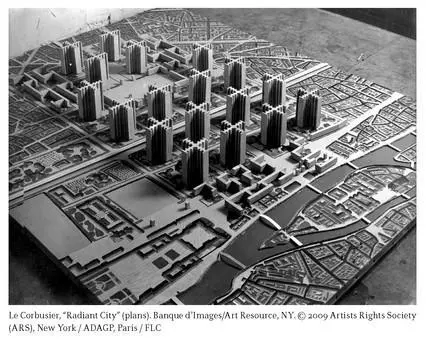
His utopian proposals—cities (just towers really) enmeshed in a net of multilane roads—were perfectly in synch with what the car and oil companies wanted. Given that four of the five biggest corporations in the world still are oil and gas companies, it’s not surprising how those weird and car-friendly visions have lingered. In the postwar period General Motors was the largest company in the whole world. Its president, Charlie Wilson said, “What’s good for GM is good for the country.” Does anyone still believe that GM ever had the country’s best interests at heart?
Maybe we can also blame Robert Moses, who was so successful at slicing up New York City with elevated expressways and concrete canyons. His force of will and proselytizing had wide-ranging effects. Other cities copied his example. Or maybe we can blame Hitler, who built the autobahns in order to allow German troops and supplies fast, efficient, and reliable access to all points along the fronts during World War II.
Читать дальше
